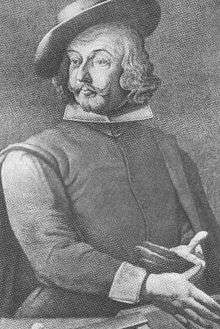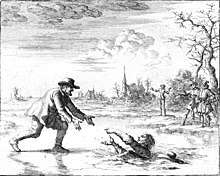Jacob Hutter
Jakob (or Jacob in English) Hutter (also Huter or Hueter) (c. 1500 – 25 February 1536), was a Tyrolean Anabaptist leader and founder of the Hutterites.

| Part of a series on |
| Anabaptism |
|---|
 Dirk Willems (picture) saves his pursuer. This act of mercy led to his recapture, after which he was burned at the stake near Asperen (etching from Jan Luyken in the 1685 edition of Martyrs Mirror |
|
Background |
|
Distinctive doctrines |
|
Largest groups |
|
Related movements |
|
|
Life and work
Hutter was born in the small hamlet of Moos near St. Lorenzen in the Puster Valley, in the County of Tyrol (present-day South Tyrol, Italy). He learned hat making in nearby Prags and became an itinerant craftsman. Later he settled in Spittal, Carinthia.
He probably first encountered Anabaptists in Klagenfurt and soon thereafter was converted to their belief. He began preaching in the Puster Valley region, forming several small congregations. As soon as the Habsburg authorities in Tyrol learned of these activities in early 1529, they began to persecute the Anabaptists. In 1527, the Habsburg archduke Ferdinand I of Austria had declared that seductive doctrines and heretical sects "will not be tolerated". In turn, Hutter and a few others went to investigate Moravia, because they heard the persecution was not as severe there. They visited Austerlitz, where they found the situation was indeed more tolerant and the Tyrolean Anabaptists decided to emigrate. As small groups moved to Moravia, Hutter first remained in Tyrol to pastor to those who remained. He escaped capture by the authorities because other captured Anabaptists would not reveal his whereabouts, even under severe torture.
Hutter arrived in Moravia in 1533, when the persecution of the Anabaptists in Tyrol was at its peak. Many Anabaptists from the Palatinate, Swabia and Silesia also went to Moravia. Hutter united the local Anabaptist congregations, enabling Anabaptism in Moravia to flourish. Under Hutter's leadership, several of the congregations adopted the early Christian practice of communal ownership of goods, in addition to their Anabaptist beliefs of nonviolence, and adult baptism.
In 1535, however, the Moravian Landtag diet had all Anabaptists expelled from Moravia and they scattered to surrounding countries. Hutter returned to Tyrol, where he and his wife were arrested on 30 November 1535 in Klausen and brought to the fortress of Branzoll (Bronzolo). On 9 December, Hutter was deported to the Tyrolean capital Innsbruck, where he was interrogated and pressured to recant. Even under severe torture he would not recant or reveal the names of other Anabaptists. Hutter was sentenced to death by fire and burned at the stake on 25 February 1536 in Innsbruck in front of the Golden Roof.[1] According to the Hutterian Chronicle, a total of 360 Anabaptists were executed in Tyrol.
Hutter's words are recorded in eight letters, written under severe persecution.
Commemoration

In Innsbruck Hutter is remembered in a street name, Hutterweg and by a plaque at the Golden Roof. Since 1992, Austrian Service Abroad, which works for worldwide understanding and reconciliation, has been located on Hutterweg.
In 2006–2007 a working group with representatives from Protestant and Catholic churches, the peace movement Pax Christi and the Association of Evangelical churches in Tyrol worked toward reconciliation with the Hutterites. On 25 February 2007 the group, along with three couples invited to represent the Hutterites, held a memorial ceremony at the Golden Roof and a joint prayer service in the old city hall in Innsbruck.[2]
Notes
- Hutterian Brethren. The Chronicle of the Hutterian Brethren. (New York: Plough Publishing House, 1987), 145 www.plough.com
- VERSÖHNUNGSZEICHEN mit den HUTTERERN Archived 2011-07-06 at the Wayback Machine
Further reading
- The Chronicle of the Hutterian Brethren (Plough Publishing House 1987)
- Brotherly Faithfulness: Epistles from a Time of Persecution (Plough Publishing House 1979)
- Hutterite Beginnings: Communitarian Experiments during the Reformation by Werner O. Packull, The Johns Hopkins University Press, 1995
- Friedrich Wilhelm Bautz (1990). "Huter, Jakob". In Bautz, Friedrich Wilhelm (ed.). Biographisch-Bibliographisches Kirchenlexikon (BBKL) (in German). 2. Hamm: Bautz. cols. 1218–1221. ISBN 3-88309-032-8.
External links
| Wikiquote has quotations related to: Jacob Hutter |
- Jakob Hutter in the Global Anabaptist Mennonite Encyclopedia Online